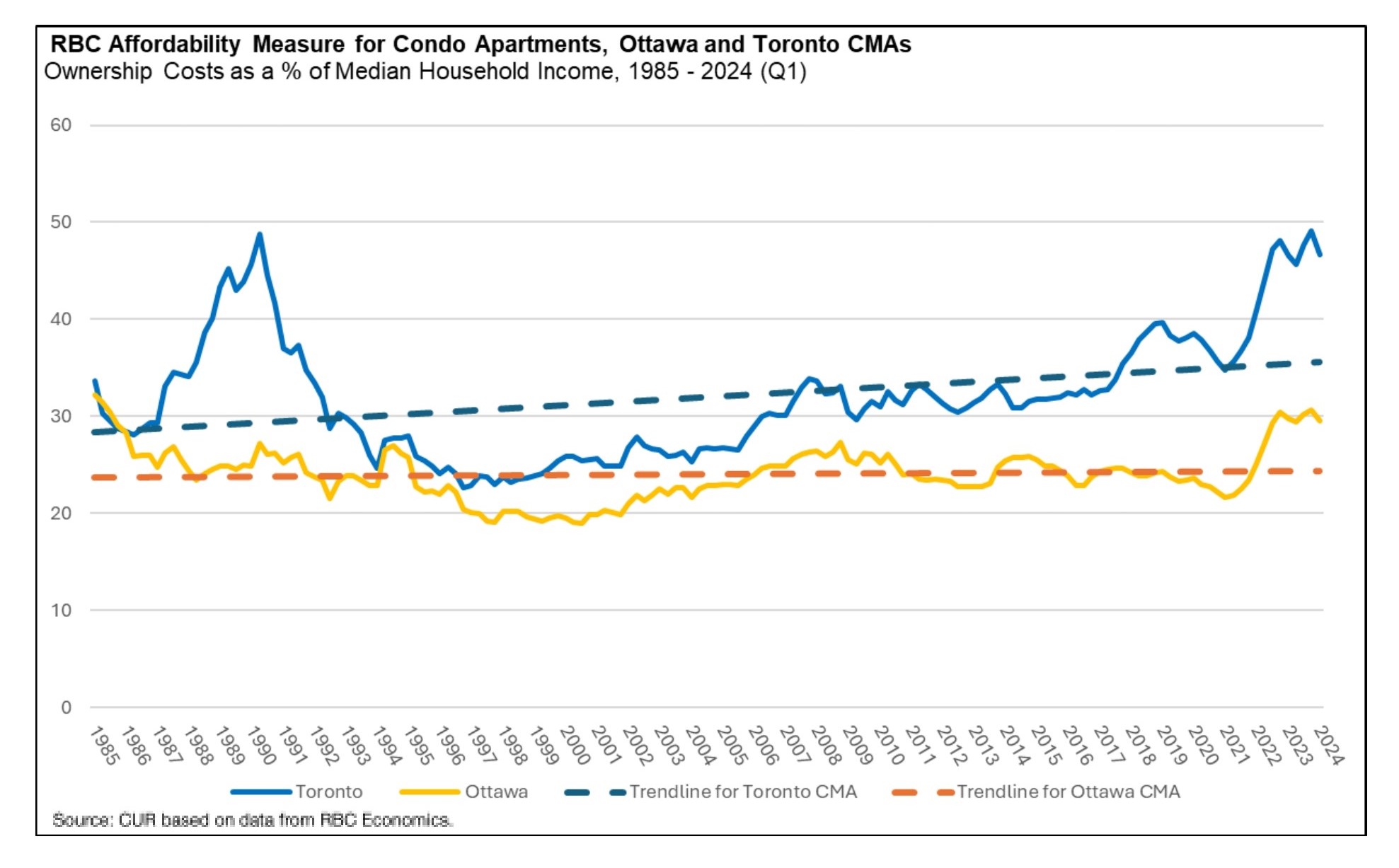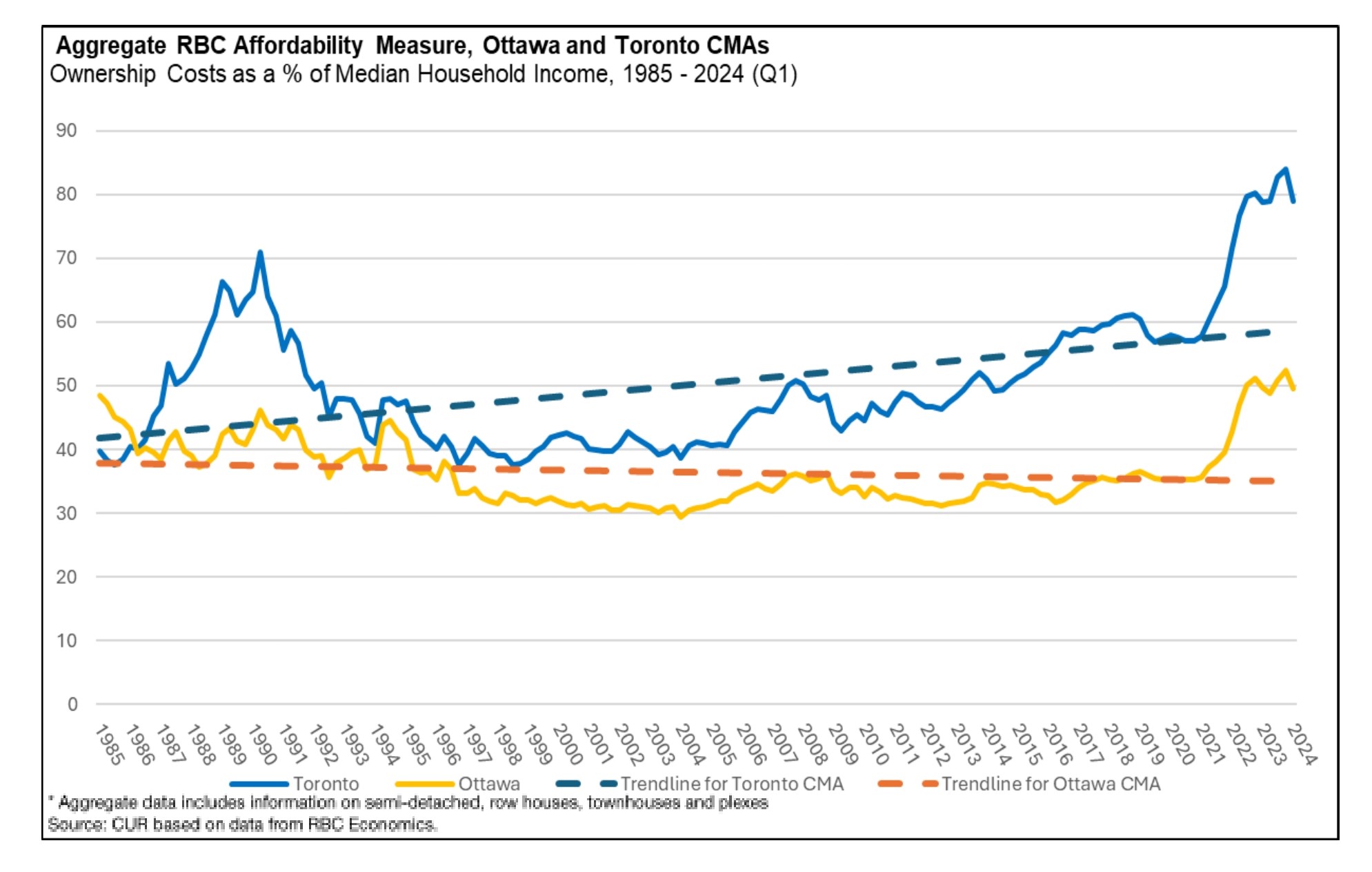An Update on Why Housing is Much More Affordable in Metropolitan Ottawa Than Metropolitan Toronto
By: Frank Clayton, Senior Research Fellow, with research assistance from Yagnic Patel
September 26, 2024
(PDF file) Print-friendly version available
Executive Summary
The results of two empirical research studies of land use planning regulations are consistent with the conclusions of CUR’s own recent study comparing affordability trends and underlying factors in the Toronto and Ottawa census metropolitan areas (CMAs). CUR’s study concluded that the widening affordability gap between the Toronto and Ottawa CMAs since the mid-1980s is primarily a product of a more stringent and fragmented land use planning structure in Toronto than in Ottawa. The two empirical studies found:
- Canada Mortgage and Housing Corporation (CMHC): “Data from the 2022 Municipal Land Use and Regulation Survey unearthed a compelling connection between land use regulations and housing affordability, particularly in highly regulated cities [municipalities].” The Ottawa CMA’s municipal land use and regulation index is an estimated 84, or 16%, lower than the Toronto CMA’s 100, and its approval delay index is 42, or 58%, less than Toronto’s 100 (lower index values mean less regulation and less approval time delay).
- Altus Economic Consulting (Altus Group): “Figure ES-5 summarizes the findings from the three (3) major elements studied that feed into housing affordability – getting housing approved, ensuring approvals are done in an expedient manner, and government charges that get borne by buyers/renters. Generally, municipalities from the Metro Vancouver and the Greater Toronto Area are found in the bottom half of the overall ranking – occupying – all are within the 10 lowest ranked municipalities [out of 21 municipalities].” The city of Ottawa ranked better in terms of affordability than any of the six Toronto CMA municipalities for all three factors. Ottawa ranked 10th in its total score. Markham, Bradford West Gwillimbury, Pickering and Toronto were in the bottom four rankings.
What can change the negative affordability situation in the Toronto region? In our view, a necessary prerequisite is creating a two-tier regional government structure similar to that implemented back in 1953 with the creation of an upper-tier municipality, the Municipality of Metropolitan Toronto, whose geographic boundaries corresponded with the boundaries of the economic region at the time (the Toronto CMA). The upper-tier municipality would be responsible for planning and coordinating on matters of region-wide interest. A two-tier government structure for the Greater Golden Horseshoe (GTA) was recommended by the 1996 GTA Task Force headed by Ann Golden.
The City of Ottawa’s boundaries should be expanded to encompass more CMA municipalities to avoid the Ottawa region slipping into the affordability quagmire created by fragmented governance, adding North Grenville, Carleton Place, and Arnprior.
The differences in regional municipal governance recommendations build on the reality of the multitude of existing municipalities in the GTA (regional, local and single-tier) and the fact the city of Ottawa already encompasses much of its commutershed.
Background
Homeownership is much more affordable in Ottawa than in the Toronto census metropolitan area (CMA). While affordability has deteriorated in both metropolitan areas in recent years due to supply shortages and rising interest rates, Ottawa’s more accommodating governance and planning structures will see a larger medium-term supply response to moderate prices.
As observed in a CUR report released earlier this year, the ability of a median-income household to purchase an average-priced single-detached house was the same in the two metropolitan regions in the mid-1980s.[1] By 2022, however, the gap had widened, and the median-income household in Toronto had to spend almost twice its income share for the same home purchase as an Ottawa household. This affordability gap for a single-detached house continued through 2023 and early 2024 (see Figure 1).
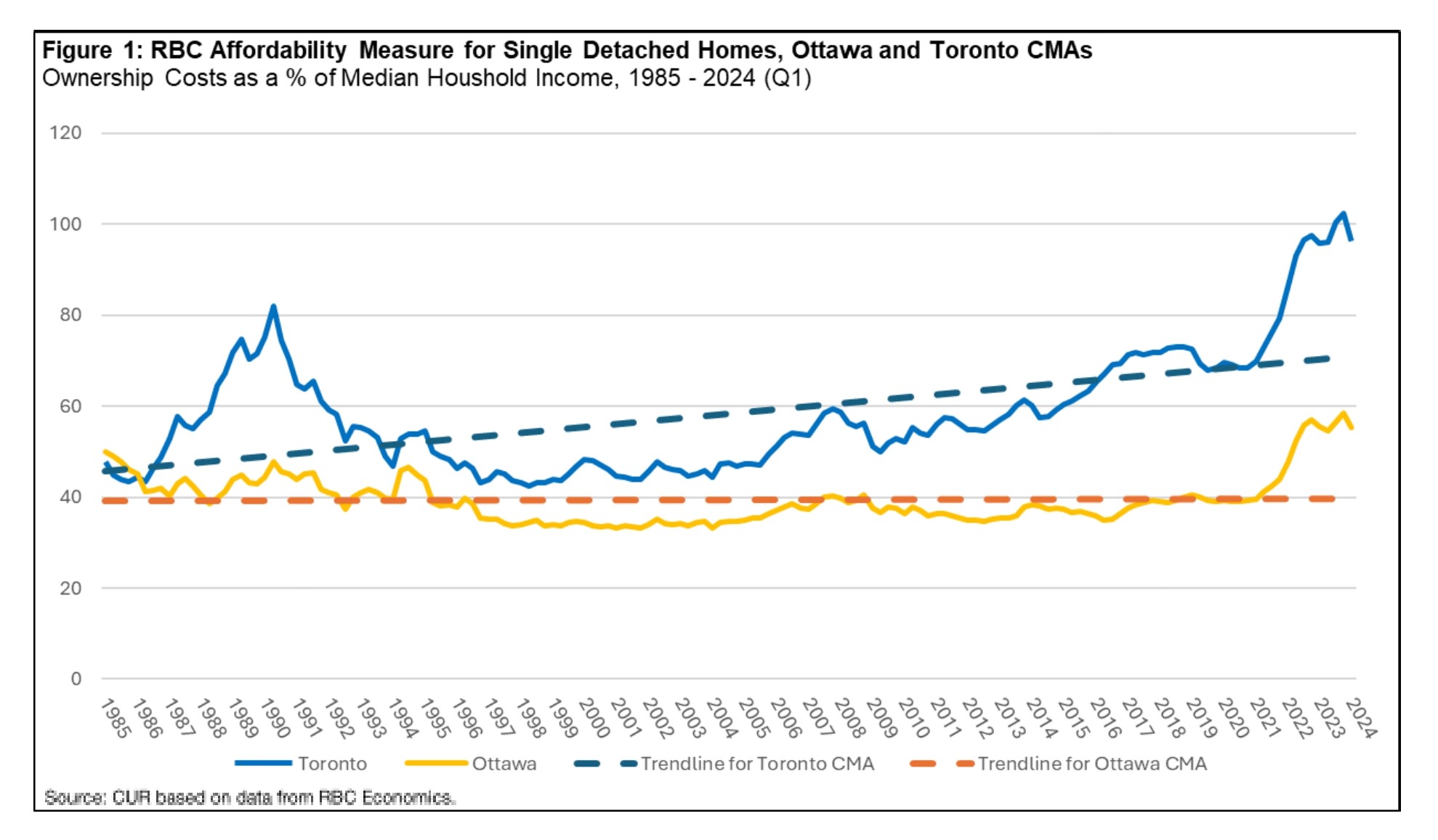
Graphs in the appendix show that condominium apartments and the aggregate affordability measure released by RBC for a composite of all unit types also experienced a widening gap between the two metropolitan areas since the mid-1980s.
The CUR report concluded that the widening affordability gap was most likely due to:
- The municipal and planning fragmentation in metropolitan Toronto versus a single dominant municipality in metropolitan Ottawa; and
- The Province’s imposition of additional Provincial planning layers on municipalities in the Greater Golden Horseshoe - but not metropolitan Ottawa (e.g.., the Growth Plan for the Greater Golden Horseshoe, the Greenbelt Act).
This blog re-examines these conclusions in light of other available relevant information.
Municipal planning regulations and approval delays are more severe in the Toronto CMA than in Ottawa – as per CMHC/Statistics Canada’s Municipal Land Use and Regulation Survey findings
CMHC and Statistics Canada worked together to develop the 2022 Municipal Land Use and Regulation Survey. Municipalities were asked questions about zoning, fees, approval times, community consultation, density limits and environmental assessments. CMHC then created two separate indexes - the Municipal Land Use and Regulation Index and the Approval Delay Index for various regions and CMAs in Canada.[2]
- The Municipal Land Use and Regulation Index – captures the degree of land use regulation in a given municipality.
- The Approval Delay Index – captures the speed of approving new developments. CMHC says this is the most crucial survey factor in understanding differences in housing affordability among various land use regulations.
Higher index values represent more regulation and slower approval times.
Figure 2 compares the two indexes for both Toronto and Ottawa CMAs.[3] Toronto is equal to 100 in the index. The figure also provides CMHC’s affordability comparison for the two CMAs.
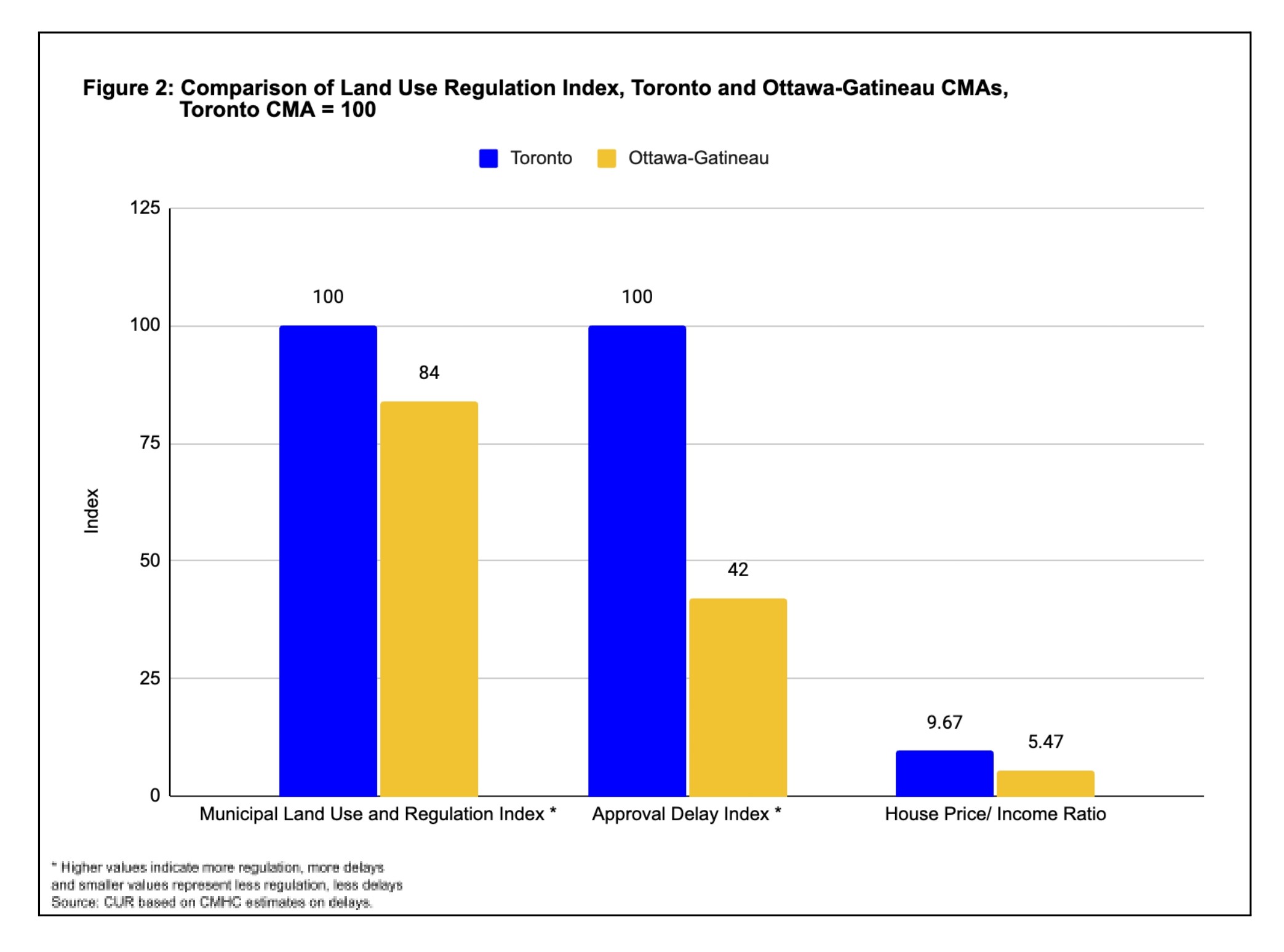
Housing is considerably more affordable in the Ottawa CMA than in Toronto, with a house price/income ratio of 5.47 compared to a value of 9.67. Housing is 43% more affordable in the Ottawa CMA.
Ottawa’s municipal land use and regulation index is an estimated 84, or 16%, lower than Toronto’s. Its approval delay index is 42, or 58%, less than Toronto’s.
CMHC concluded that, “data from the 2022 Municipal Land Use and Regulation Survey unearthed a compelling connection between land use regulations and housing affordability, particularly in highly regulated cities [municipalities].”[4]
The affordability gap between the Toronto and Ottawa CMAs is primarily a product of more stringent and fragmented governance and more onerous land use planning regimes in Toronto than in Ottawa.
CHBA-sponsored study finds Ottawa’s planning regime and government charges more positive for housing affordability than in Toronto CMA municipalities surveyed
The Canadian Home Builders’ Association (CHBA) retained Altus Group Economic Consulting (Altus Group) to undertake a study of municipal factors that may be contributing to housing affordability issues.
These include:
- Municipal approval processes;
- Timelines for approvals; and
- Government charges levied by municipalities.
The study examined 21 municipalities across Canada, including one in the Ottawa CMA and six in the Toronto CMA.
Figure 3 presents the ranking of the Toronto and Ottawa CMA municipalities out of the 21 municipalities surveyed.
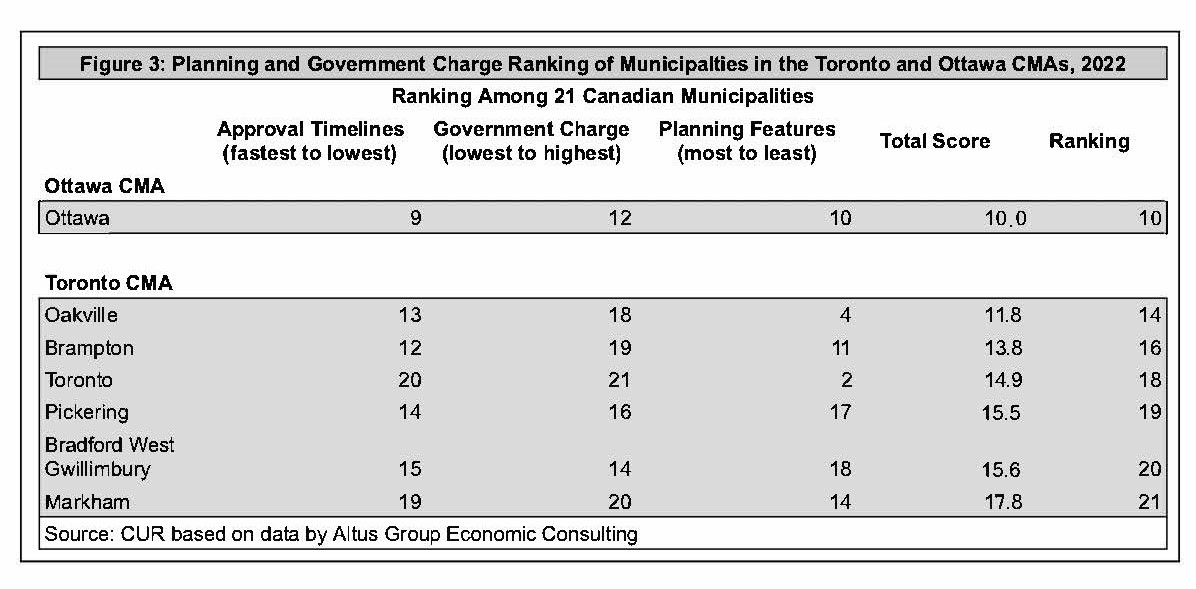
Ottawa ranks better in affordability than the municipalities in the Toronto CMA for all three factors – approval timelines, government charges and planning features. As a result, Ottawa’s total score and ranking, based on those three factors, is lower than that of any of the surveyed municipalities in the Toronto CMA. Out of 21 municipalities, Ottawa ranked tenth. The Toronto CMA municipalities ranked from 14 (Oakville) to 19-21 (Toronto, Pickering, Bradford West Gwillimbury, and Markham).
The Altus Group study findings are consistent with those of the 2022 Municipal Land Use and Regulation Survey – the planning regime is more conducive to housing affordability in the Ottawa CMA than in the Toronto CMA.
Concluding Remarks
The 2022 Municipal Land Use and Regulation Survey and the Altus Group study for CHBA are consistent with the conclusions of CUR’s own recent study comparing affordability trends and underlying factors in the difference between Toronto and Ottawa CMAs.
What can change the negative affordability situation in the Toronto region? In our view, a necessary prerequisite is creating a two-tier regional government structure similar to that implemented back in 1953 with the creation of an upper-tier municipality, the Municipality of Metropolitan Toronto, whose geographic boundaries corresponded with the boundaries of the economic region at the time (the Toronto CMA). The upper-tier municipality would be responsible for planning and coordinating on matters of region-wide interest. A two-tier government structure for the Greater Golden Horseshoe (GTA) was recommended by the 1996 GTA Task Force headed by Ann Golden.[5]
The City of Ottawa’s boundaries should be expanded to encompass more CMA municipalities to avoid the Ottawa region slipping into the affordability quagmire created by fragmented governance, adding North Grenville, Carleton Place, and Arnprior.
The differences in regional municipal governance recommendations build on the reality of the multitude of existing municipalities in the GTA (regional, local and single-tier) and the fact the city of Ottawa already encompasses much of its commutershed.
A word of caution however, consolidating municipalities within a census metropolitan area is necessary for more affordable housing but is not always sufficient. Hamilton is a conspicuous illustration of this. The city’s boundaries encompass all of the Hamilton CMA except for the town of Grimsby and the city of Burlington. Yet Hamilton’s Council opposes greenfield development in favour of densification of the existing built-up area.[6] This policy ignores the reality that development is required both on greenfield lands and in built-up areas to provide a range of housing types and improve affordability in the Hamilton region.
End Notes
[1] Frank Clayton. The Housing Affordability Benefits of Commutershed Land Use Planning: A Case Study of the Ottawa and Toronto Metropolitan Areas. CUR. February 6, 2024.
[2] CMHC. Approval Delays Linked With Lower Housing Affordability. July 13, 2023. CMHC has not released the details of how the two indexes were constructed.
[3] The CMHC estimates are for the Ottawa-Gatineau CMA. The Ontario portion of the CMA is much larger than the Quebec portion.
[4] CMHC. A Comprehensive Retrospective of CMHC Housing Reports: What We Learned in 2023. December 20, 2023.
[5] Report of the GTA Task Force. January 1996. The Task Force supported and proposed that the existing regional governments (six at the time) be replaced with a single Greater Toronto government that has clear responsibility for planning and coordination on matters of region-wide interest.
[6] The August 2023 Urban Hamilton Official Plan states, “the City shall plan to achieve a minimum of 80% of all residential development occurring annually within its built-up area.”
References
Canada Mortgage and Housing Corporation (2023). ‘Approval Delays Linked With Lower Housing Affordability.’ July 13, 2023. [Online]. Available: https://www.cmhc-schl.gc.ca/blog/2023/approval-delays-linked-lower-housing-affordability (external link)
Canada Mortgage and Housing Corporation (2023). ‘A Comprehensive Retrospective of CMHC Housing Reports: What We Learned in 2023.’ December 20, 2023. [Online]. Available: https://www.cmhc-schl.gc.ca/blog/2023/comprehensive-retrospective-cmhc-housing-reports (external link)
City of Hamilton (2022). ‘Urban Hamilton Official Plan.’ November 2022. [Online]. Available: https://www.hamilton.ca/build-invest-grow/planning-development/official-plan/urban-hamilton-official-plan (external link)
Frank Clayton (2024). ‘The Housing Affordability of Commutershed Land Use Planning: A Case Study of Ottawa and Toronto Metropolitan Areas.’ CUR. February 6, 2024. [Online]. Available: (PDF file) https://www.torontomu.ca/content/dam/centre-urban-research-land-development/pdfs/Toronto_Ottawa_CMA_Comparison_CUR.pdf
Greater Toronto Area Task Force (1996). ‘Greater Toronto: Report of the GTA Task Force.’ January 1996.
Appendix: RBC Affordability Measures for Condominium Apartments and the Aggregate of All Housing Types, 1985= 2024 (Q1)
